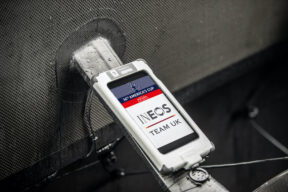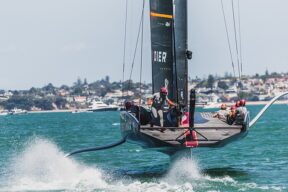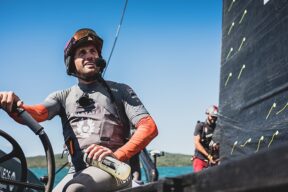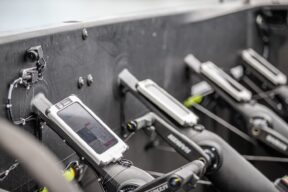Building the Tools for Winning Tactics
Coderus helped deliver race-critical data clearly and quickly to INEOS TEAM UK with a Tactical Aid App.
At a Glance
- The app displays tactical information using live data.
- The technology is delivered to multiple tablets on the boat.
- We used the agile methodology to provide rapid updates and improvements based on sailor feedback.
- We built the functionality to record and replay all displays running on the boat.



The Challenge
There are many factors that determine who wins and who loses a sailboat race. The ones that are obvious to the casual spectator are speed and manoeuvrability, along with efficiently managing the interactions with other competitors. These are the same kinds of elements that win motorsport races.
There is another layer of factors determining the outcome in sailboat racing though – often visible only to the aficionado – and they come from the complexities that motor racing does not have to contend with:
- Instead of a reliable, driver-controlled power supply (an engine), the boat’s power source – the wind – varies unpredictably in both speed and direction and relative to both time and position on the racecourse.
- Instead of a tarmac or gravel track with a clear, optimal ‘racing line’ there is no fixed route around the course, just markers that must be rounded on a particular side, and an optimal route between them that will vary with the wind, current and sea state.
The variability of the power source and the lack of constraint on the boat’s course lead to a multitude of questions. Where’s the best wind? How do I get to it? How much confidence do I have in the wind not changing before I get to it? Do I stick with my competitors or back my judgement on a shift in wind direction or speed?
The answers to these questions play a big part in winning races and finding the right answer is largely the job of the tactician. The most experienced of these are extremely good at assessing many of the relevant factors; judging the speed of the boat by movement relative to the competition, or judging the wind strength and direction by the effect it has on other boats, on the water, and on trees, smoke or flags on the land.
These judgments are synthesised, and a decision reached – based on experience – on the best tactics. And for much of the long and illustrious history of the Cup – and in smaller boats even today – this was the only way to do it.
The advent of satnav and its integration into a multi-sensor instrument system via powerful onboard computers has been a real game-changer though. The data can now be fed to a screen on the deck and software developed to help assess the tactical options.
The Methodology
In the 35th America’s Cup, the team built a bespoke package tailored to the new boat and the racecourse. It had to work very differently to traditional tactical software which had historically been run by a navigator with few other responsibilities.
The new ‘tactical app’ had to consider not just the completely different way that it would be used – with almost zero time for the tactician to interact with the screen – but also the fact that the strategic dynamics had fundamentally changed with the introduction of tight boundaries to the racecourse.
The task of developing the tactical app was split into two parts, the first of which required intensive sailing maths. The app would rely on a lot of sophisticated calculations to produce all the numbers that would be displayed. These calculations would be done by the team’s in-house software engineers, led by Andy Bryson.
The second part of the job was to develop the app to display the data and graphics on the deck screens in the most efficient and effective way possible. This task required a different skill set, obviously, input was needed from the tactician and other sailors, but the team also needed experience in mobile app design. So a partnership was created with Coderus, a software development company based at Adastral Park in Suffolk; one of their specialisms is mobile app solutions.
The tactical app went through many iterations in the previous America’s Cup. Tactician and Olympic gold medallist Giles Scott commented at the time: “We were desperate for an app which could act as a virtual seventh crew member and become central to our decision making process during the race, providing Ben (Ainslie) and I with the data that we really need to gain a competitive advantage. We’ve had great support from Coderus through all stages of the development, from design, build and now refinement out on the water.”
Now, for the 36th America’s Cup, the boat and the racecourse have changed again, and the band must reform to develop the tactical app for its new role. Andy Bryson is in charge of the project and will be coding the sailing maths; Giles Scott remains the tactician and will be inputting the sailor’s viewpoint – and both are delighted that once again Coderus as a technology partner will be working on the tactical app.

